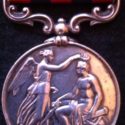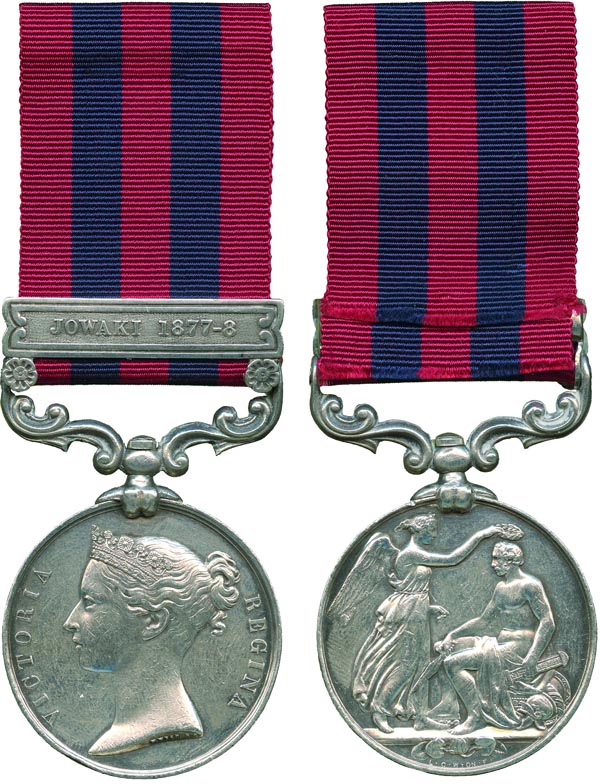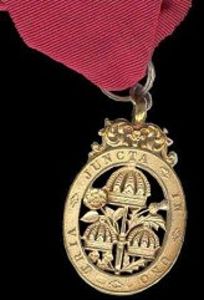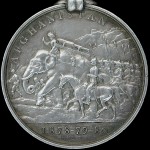A Scion Society of The Baker Street Irregulars

The Indian General Service Medal of Colonel Sebastian Moran
“This, gentlemen, is Colonel Sebastian Moran, once of Her Majesty’s Indian Army …”
– The Adventure of The Empty House (EMPT)

After the arrest of Colonel Sebastian Moran in The Final Problem, Holmes and Watson retire to 221b Baker Street. While conversing, Watson mentions that he was not familiar with the Colonel. Holmes looks through his index of biographies and hands over the volume of M’s to Watson.
He handed over the book, and I read: ‘ Moran, Sebastian, Colonel. Unemployed. Formerly 1st Bengalore Pioneers. Born London, 1840. Son of Sir Augustus Moran, C.B., once British Minister to Persia. Educated Eton and Oxford. Served in Jowaki Campaign, Afghan Campaign, Charasiab (dispatches), Sherpur, and Cabul. Author of Heavy Game of the Western Himalayas, 1881; Three Months in the Jungle, 1884. Address: Conduit Street. Clubs: The Anglo-Indian, the Tankerville, the Bagatelle Card Club.’

We learn from Holmes entry that Moran’s father, Sir Augustus was a Companion of the Most Honourable Order of the Bath, Civil Division. We’ll save that for a future post.

In addition, we glean that Colonel Moran served during the Afghan campaign and would have earned the Afghanistan Campaign Medal. The mentions of Charasiab and Cabul indicate that his campaign medal would have two clasps, one for each. We’ve discussed this medal before HERE and in more detail HERE.
We knew that the Colonel served in the Indian Army from when Holmes revealed his identity, immediately after his arrest. We now know that Moran participated in the Jowaki campaign while there. These two facts tell us that Moran thus earned the Indian General Service Medal with a Jowaki campaign clasp.
The Indian General Service Medal was established in 1854 and was awarded to troops who took part in various battles and skirmishes in India from 1854 until 1895. The badge is always accompanied by at least one clasp (there were 24 clasps authorized in total) and many medals exist with multiple clasps.
The medal is a 36mm round silver medal featuring a left-facing effigy of Queen Victoria on the obverse. Bronze versions of the medal exist, as they were awarded to Indian civilians starting in 1885. The reverse features a seated nude figure being crowned by Victory. Just below this are leaves and flowers from a lotus plant.
The medal hangs from a silver scroll bar which is attached to the medal with a double toe claw. The ribbon for the medal is 33mm in width and has five alternating stripes, three red and two dark blue.
As mentioned earlier, this medal is always awarded with at least one clasp and Moran would definitely have received the Jowaki 1877-8 clasp. The other 23 clasps that were eligible to be issued are: Pegu, Persia, North West Frontier, Umbeyla, Bhootan, Looshai, Perak, Naga 1879–80, Burma 1885–87, Sikkim 1888, Hazara 1888, Burma 1887–89, Burma 1887–9, Chin Lushai 1889–90, Lushai 1889–92, Samana 1891, Hazara 1891, NE Frontier 1891, Hunza 1891, Burma 1889–92, Chin Hills 1892–93, Kachin Hills 1892–93 and Waziristan 1894–95.
I would welcome comments regarding if Colonel Moran would have been eligible for any of these other clasps.

Sorry, comments are closed for this post.